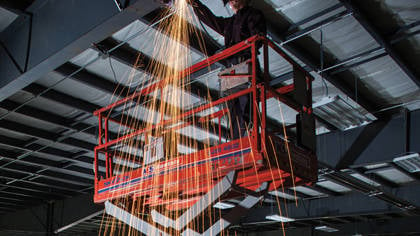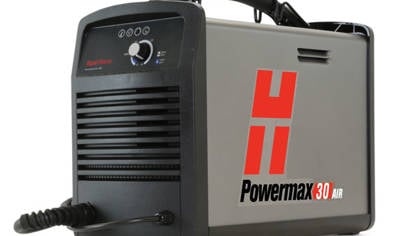Plasma cutting on the go
Earlier today, Hypertherm introduced a brand new product to its line of Powermax® air plasma systems: the Powermax30® AIR. The Powermax30 AIR is unique in our line because it features an internal air compressor. This means people using this system don't need to worry about hooking up a separate compressor. They simply need the Powermax30 AIR and a power source and they can start cutting (or gouging.) The system delivers some pretty impressive performance, nothing like the integrated plasma/compressor units you may remember from the days of old. For example, it can cut 5/16″ and sever twice that thickness. But this post actually isn't supposed to be about the Powermax30 AIR. What this post is actually supposed to be about is mobile cutting in general.
What tools do we use to cut material (could be metal or something else like stone or rubber) in the field? After all, for many of us, our jobs don't just take place in a shop or garage. It could be that you work in the mines, or on a ship, or maybe you do HVAC work and need to work up on a ladder installing duct work. Pipelines are another example. Crews constructing these lines are often on the line, or right-of-way as its called, away from both an air and power source.
Zeroing in on just metal, you essentially have two choices right now, choose a manual tool like a saw, shear, or grinder or choose a thermal method like plasma or oxyfuel.
The size of these tools and investment required obviously varies. There is no doubt manual tools are incredibly portable, after all the tools are small and electricity is not needed. The drawback, however, is that these tools cut slowly and the resulting cut is sure to be somewhat crude. Because of that, the use of these tools is best limited to instances were minimal and occasional cutting is required.
For larger jobs, it is probably worth stepping up to one of the thermal methods like oxyfuel or plasma. Oxyfuel is nice because the equipment itself doesn’t cost much. You can be up and running fairly quickly. However, the process is comparatively slow and only good for cutting carbon steel (no stainless steel or aluminum.) In addition, the carbon steel you plan to cut must be preheated before cutting, further reducing productivity. Finally, there are safety issues associated with the use of acetylene, the most common fuel gas used with this process, as it is highly flammable and unstable. You can only carry so many cylinders in the back of your truck before someone at the Department of Transportation is unhappy.
This brings us to plasma. The combination of cut quality, productivity, operating cost, and versatility make plasma the most popular industrial cutting process around. It can cut most any type of conductive metal—mild steel, stainless steel, aluminum, copper, brass, and more—even if rusted, painted, or dirty. Plasma can also cut expanded metal, and is good at cutting both thick and thin metal. But perhaps the best attributes of plasma are safety and ease of use. Plasma does not require the use of flammable gasses and there is no open flame. In addition, the process itself is easy to master.
The downside to air plasma is that it costs more to buy than oxyfuel and it requires both an air compressor and power source. However, newly introduced technologies make plasma more portable than ever by including built-in air compressors, like our new Powermax30 AIR, or generators.
What do you think? Do you agree with this analysis? What do you do when needing to cut material out in the field?



